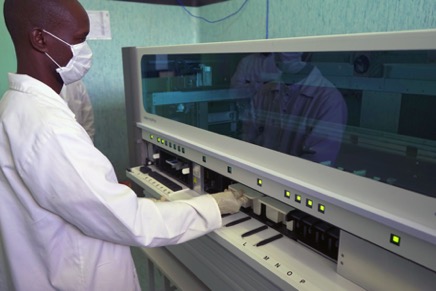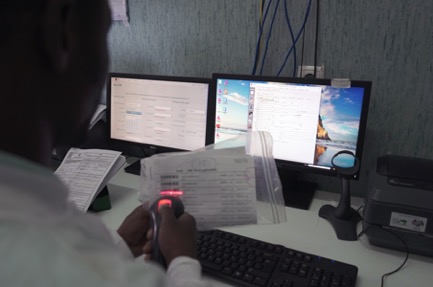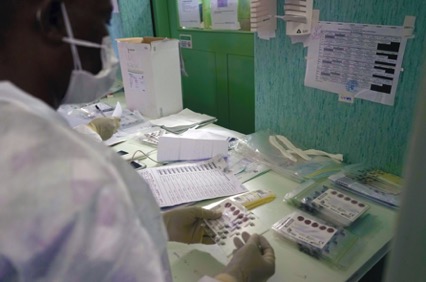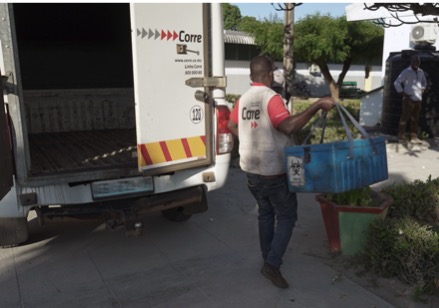Dramatic reduction in specimen turnaround time and access to thousands of viral load results offers significant life-saving opportunities

Viral load sample verification
Photo credit: Rui Esmael

Viral load sample registration into DisaLab
Photo credit: Rui Esmael

Viral load sample verification
Photo credit: Rui Esmael

Viral load samples are transported by CORRE
Photo credit: Rui Esmael
The marked increase in the availability of viral load (VL) results, a critically important laboratory test to monitor the adherence to and effectiveness of combination antiretroviral therapy (ART), has offered significant opportunities for improving the health of thousands of adults and children living with HIV in Zambézia Province, Mozambique. Interventions have been made at various levels of the laboratory sector in recent years, led by the Provincial Directorate of Health of Zambézia (DPS-Z), with the support of Friends in Global Health (FGH), and made possible thanks to funding from the President's Emergency Plan for AIDS Relief (PEPFAR), provided through the Centers for Disease Control and Prevention (CDC).
Viral load analysis measures the amount of HIV RNA in a patient’s blood sample. Knowing an ART-treated person’s viral load helps medical providers assess the effectiveness of a patient's HIV/AIDS treatment. Viral load results below the lower limits of detection indicate that a patient is adherent to their prescribed ART regimen and that their body is responding well to therapy. A high or increasing viral load can be a warning of non-adherence and/or the development of HIV drug resistance. Cele Carlos Vitorino is head of the Molecular Biology Laboratory [MBL] at the Quelimane General Hospital [QGH], the only laboratory in the province equipped to process VL samples.
He tells us, “One of the main objectives of viral load is the monitoring of HIV positive patients’ treatment, so that we can see if it is having an effect or not, in terms of patient adherence.”
In the past, VL samples had to be processed and shipped all the way to the DREAMS laboratory (Determined, Resilient, Empowered, AIDS-free, Mentored and Safe Program) in Maputo. Viral load results could take more than four months to return to the requesting health facility, during which time a patient may have continued to have suboptimal adherence without any follow-up or intervention. Beginning in 2015, with the installation of laboratory equipment at the QGH MBL and the strengthening of the sample referral system, all ART-treated patients from the 196 FGH supported health facilities (HF) in Zambézia Province currently have access to VL services. There has been a dramatic increase in the number of motorcycles in use to support daily VL sample transport from peripheral HFs to District Sede HFs. FGH has also contracted third-party services through CORRE (Correio Expresso de Moçambique – express mail services) for sample transportation from District Sedes to the QGH MBL twice a week. Viral load results are now returned to the ordering HF within an impressive 10 days, an average. A team of three FGH sample managers, three digitizers and a laboratory mentor support the various operations at QGH that enable quality and timely VL results. “In this process, the role of FGH is very innovative and very important for the lab, in terms of interaction with the health facilities,” emphasizes Cele Carlos Vitorino.
In addition, the DisaLink laboratory results system has been installed in all FGH-supported districts except Mulevala to ensure that district-level VL requests are immediately available at QGH. Once results are processed at QGH, they are made available in real-time to the District Sedes, saving time and other additional resources. To this end, FGH has contracted twenty-four digitizers based in the District Sede HFs and other high-volume HFs. The staff support DisaLink systems operations and enter results into OpenMRS, making the results available to the provider to properly inform and guide clinical care decisions for their patients. Today, over 16,000 VL results are provided monthly, compared to approximately 7,000 per month a year ago.